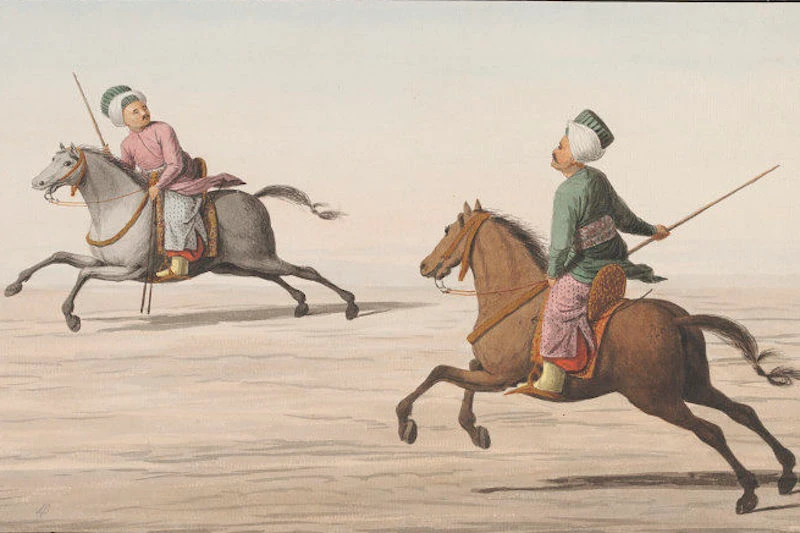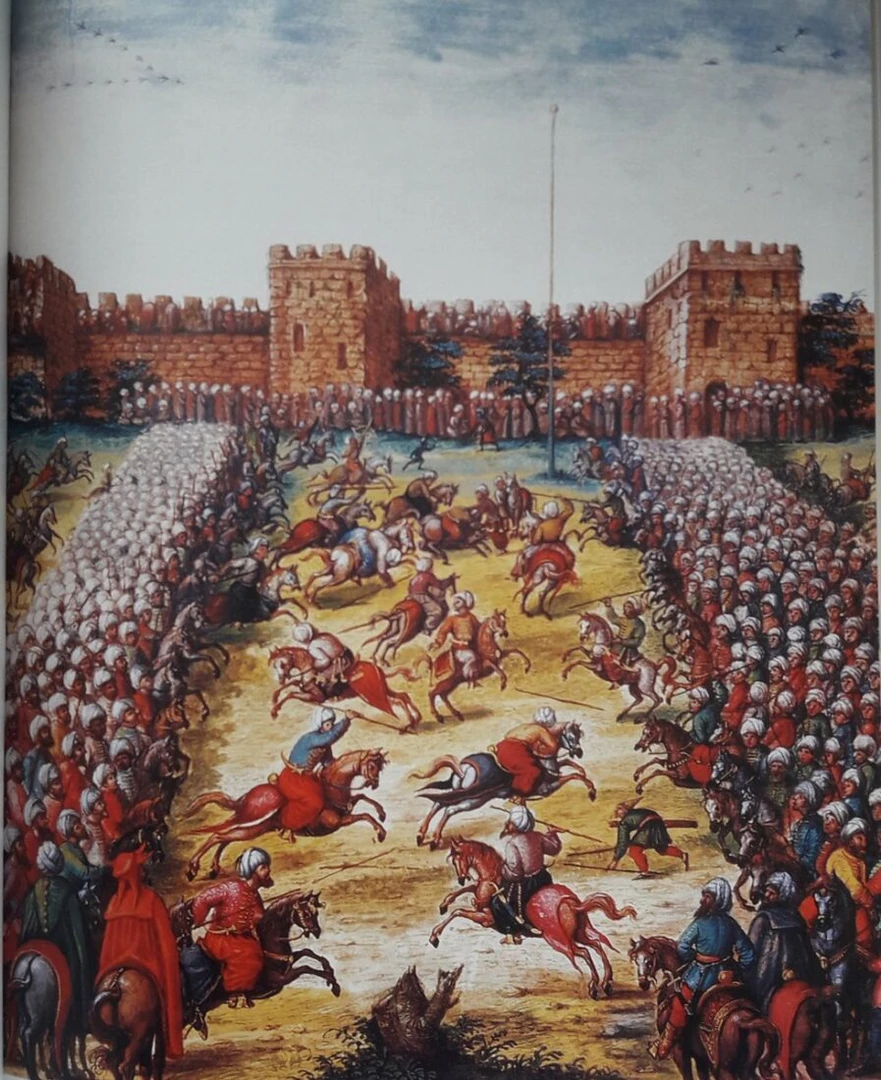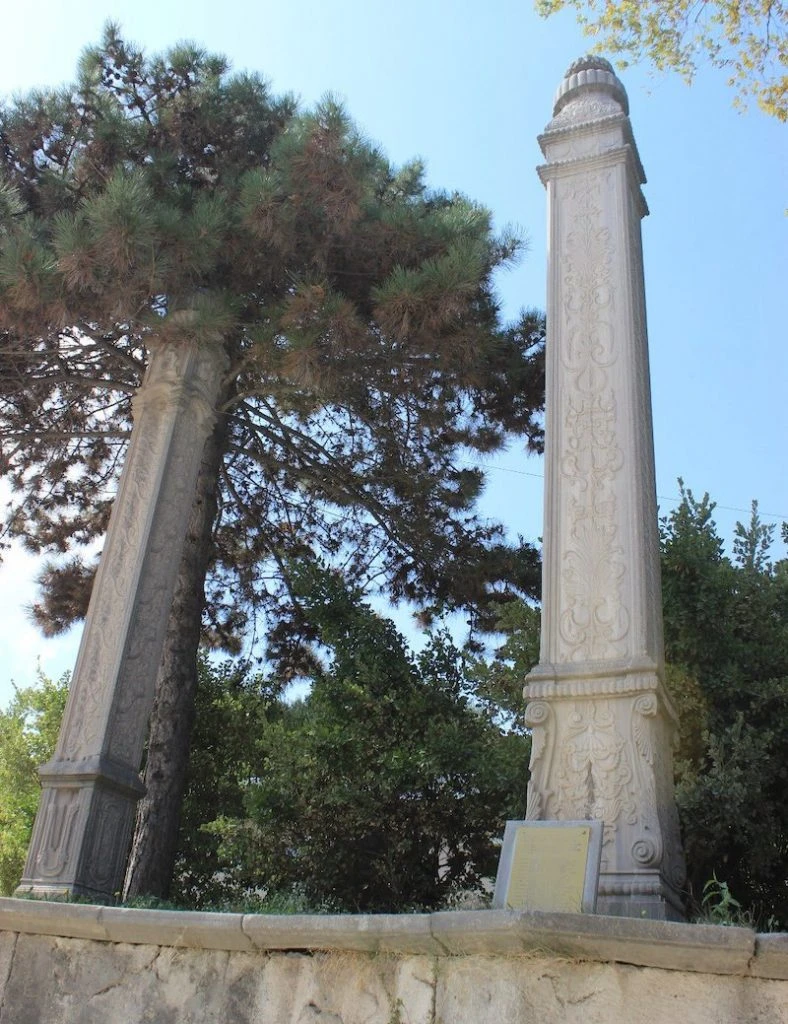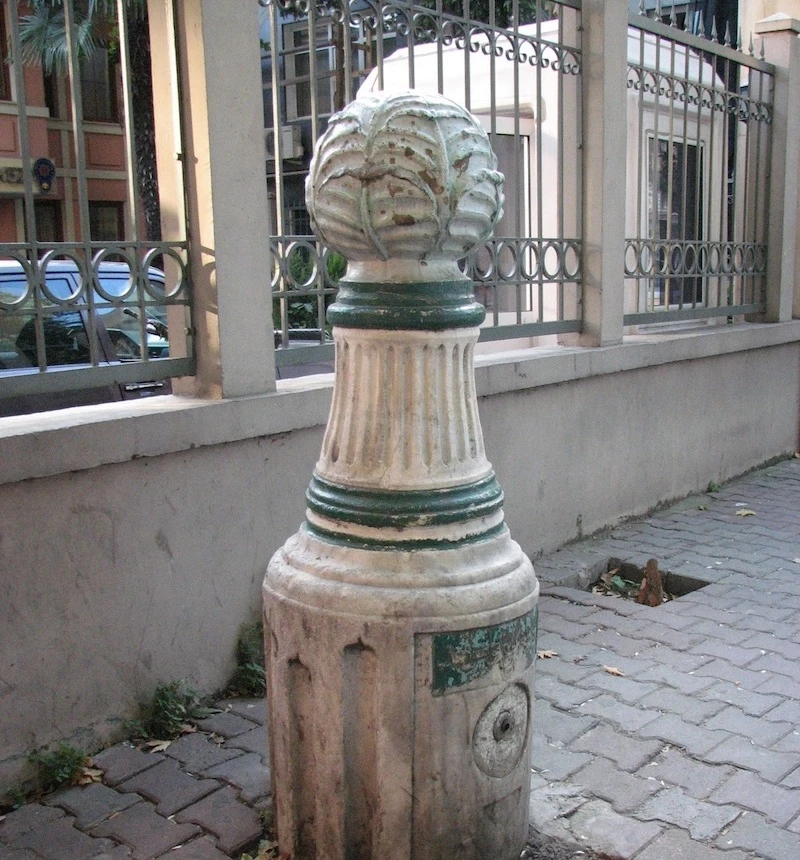Cabbages vs. Okras: Eternal rival teams in the Ottoman Palace
 Two Ottoman soldiers on horseback engaged in the game of coman - a stick game. (Origin of visual unknown)
Two Ottoman soldiers on horseback engaged in the game of coman - a stick game. (Origin of visual unknown)
“Under the grand trees, after performing prayers as a good custom and tradition, the Inner Palace (Enderun) aghas were permitted to sit in the presence of the Sultan. Following this, an order was given for the cavalry to play javelin. About 80 horsemen entered the field and displayed their strength. They threw their clubs two minaret lengths into the air. Then, dismounting from their restless horses, they lined up behind their chief and elder, the sergeant of the chamberlains, Atkafali Mehmet Agha, and appeared before the Sultan to receive their rewards. After kissing the ground, they returned to their respective regiments. These regiments were two in number, one called the Cabbage faction and the other the Okra faction. Thus, in these events with their peculiar names, half of the horsemen were Cabbage supporters, and half were Okra supporters.
Upon the Sultan’s signal, the guides played their tunes, and the Cabbage and Okra regiments ceremoniously passed each other before engaging in javelin play. As the javelins began to fly from the Okra regiment, the knees of the cowards began to tremble. Lezgi Mehmet Agha, whom the Sultan favored from the Okra faction, along with Deaf Nashit Agha, Tatar Ahmet Bey from the expeditionary forces, Tall Muharrem Agha from the harem aghas, Solak Cevher, and others, launched such an attack on the Cabbage regiment that their thrown javelins nearly resurrected their opponents. The Cabbage supporters, with their lives at stake, met the javelins with their mallets and appeared to charge their rivals like swift Tatars.
Against the renowned Shuayip and Kazmaci Server Aghas from that side, the Janissary Shakir Agha, Kato Hasan Agha, Ashkar Ali Agha, Aslan Salih Effendi, and others, ‘to give strength to the cabbage and flavor to the okra,’ attacked the Okra faction with such ferocity and fury that it was impossible to extinguish. This spectacle was one that would be talked about until the end of time. The Okra supporters, though not without their own vigor, changed horses and counterattacked. As the Buyukdere stream turned into a battlefield, the Sultan, seeing that this intense javelin play, carried out with such determination, would lead to the deaths of the opponents, stopped the game. The horsemen, their minds in a whirl, then left the field.“
This is how Hafiz Hizir Ilyas, the author of ‘Letaif-i Enderun’, describes the javelin competition held in the presence of Sultan Mahmud II in Buyukdere on the third Thursday of 1812. Hizir Ilyas Agha reports that the Sultan, with his imperial procession, especially on Mondays and Thursdays when the weather was clear and the sea calm, would take the Inner Palace (Enderun) aghas and his companions and embark on a journey called ‘binis’, either by land or sea.
Thus, hundreds of aghas, who spent their lives within the walls of Topkapi Palace, would take a breath of fresh air and find joy. During these excursions, various shows and entertainments were organized. Among these, sports games were prominent. Ottoman sports consisted of wrestling, tomak (a mace game), archery, horsemanship, ball games, and especially traditional javelin matches.
In these sports games, the players were divided into two groups, one called the ‘cabbages’ and the other the ‘okras’ (“Lahanacilar” and “Bamyacilar”). Sometimes one team consisted solely of aghas, while the other was formed from black harem aghas. The ‘cabbages’ wore green velvet clothes and carried green flags, while the ‘okras’ wore blue attire and carried red flags. Spectators would cheer, shouting ‘strength to the cabbages, flavor to the okras’, increasing the excitement. The chamberlain aghas would organize competitions such as javelin, lobut (a club game), comak (a stick game), and wrestling among the pages of the inner palace, treasury, pantry, and expeditionary wards.
The Sultan would descend to one of the Pearl (Incili), Ishakiye, Gulhane, or Tiled (Cinili) pavilions and watch the competitions held in the sand, gourd, Gulhane, or arsenal squares in front of the pavilion. The grand competitions held in the horse square or archery square could be watched by the public. The aim of the javelin, lobut, asirma (obstacle course), and comak throwing competitions, in which the sultans who ascended the throne at a young age sometimes participated, was to accustom the young men taken into palace service to riding and horsemanship, and not to leave them without faith.

For this purpose, the young men taken into the inner palace were taught riding, swordsmanship, javelin, archery, lobut, and marksmanship in the Gulhane garden of Topkapi Palace, the arsenal square, the fifth courtyard, and the tiled square of Besiktas Palace. Those who participated in these trainings and demonstrated success received the title ‘ustad-i cundi’ and joined the ‘keskinler’ class of the inner palace pages. The keskinler, as they displayed successful games and skills with their superior talents, were rewarded by the Sultan.
Young sultans like Murad IV also participated in their daily tests. In competitions lasting 5-10 days, the most successful cundi was awarded a horse called ‘kusi’, which was brought to the center of the square as a prize. Kato Hasan, one of the cundis who gained great fame in the last period of the Enderun, was unrivaled in hitting and defending with the lobut (mace) and had won the kusi horse several times. Hizir Ilyas, in his Letaif-i Enderun, describes the arrival of Sultan Mahmud II to the Gulhane pavilion and the conduct of the games as follows: “On Tuesday, the fifth day of the month of Rebiulahir, the exalted Sultan graced the Gulhane pavilion and requested the aghas to play tomak (mace game). He liked the games and the noble pockets of the aghas were filled with money. Then, javelins were thrown. Kato Hasan Agha threw his javelin farther than anyone else. Upon this, the aghas, who gave up throwing javelins, expressed their jealousy with various words. Seeing this, His Majesty Mahmud Khan gifted Kato Agha with an adorned and decorated horse. And Kato swore to compete with anyone who wished to challenge him.”
The Cabbage-Okra competitions, which were repeated for four hundred years, continued until 1828. In the rivalry between the cabbage and okra factions, there were supporters among viziers, pashas, and even sultans. When the transition to the style of European palaces began in the 1830s, these cadres were disbanded, and traditional palace sports were suddenly forgotten. The symbols of these two powerful teams can still be seen in the hearth of the princes’ quarters in the harem of Topkapi Palace.
Origin of Cabbage-Okra rivalry
Sultan Celebi Mehmet, who gained fame for his wrestling and archery skills during his time as a prince, organized competitions for his riders while he was the governor of Amasya. On one occasion, during a horse race and javelin games held in Suluova, two hundred cavalrymen from Merzifon, known for its cabbages, and two hundred from Amasya, known for its okras, competed fiercely in javelin. The spectators shouted: ‘Hail the okra supporters! Hail the cabbage supporters!’ From then on, it became a custom to refer to the opposing sides as okra and cabbage supporters in competitions between palace organizations.
Abdurrahman Seref Bey, in one of his articles introducing Topkapi Palace, writes that, according to what he heard from palace veterans, there was an okra supporters’ ward belonging to the Bostanci Corps inside the palace’s hay gate, and that one of the two old towers in the arsenal square represented the okra supporters’ ward, and the other represented the cabbage supporters’ ward. In the same place, on two obelisks erected during the reigns of Selim III and Mahmud II, which still stand today, the first one has a cabbage head figure at the top, and the other has an okra head figure. It is understood from the inscriptions on the stones that the cabbage obelisk was erected in 1790 (Hijri 1205) at the place where Selim III’s arrow fell during an archery competition held in the arsenal square, and the other one relates to Mahmud II’s rifle shot during another competition in 1811 (Hijri 1226).

Tayyarzade Ata Bey, the author of ‘Tarih-i Enderun’, writes that the bostanci (palace gardeners) belonging to the cabbage ward grew cabbages in the palace gardens. Ahmet Efendi, the secret scribe of Selim III, also mentions similar stories in his diary for this Sultan, and Hizir Ilyas Agha, in his ‘Letaif-i Enderun’ written during the Mahmud II period, includes stories of okra and cabbage competitions that were held during the reigns of earlier sultans, and even that princes who received riding and archery training from the most skilled masters participated in these competitions.
‘Vaka-yi Sultan Cem’, which narrates the life of Cem, the young son of Mehmed the Conqueror, records that during the reign of Bayezid II, competitions held in front of the Chinese Pavilion were attended by Prince Ahmet, his brother-in-law Akkoyunlu Gode Ahmet Bey, Crimean princes, and Serbian, Polish, and Hungarian princes. An obelisk erected in memory of Prince Ahmet, who participated in an archery competition in the arsenal square of Topkapi Palace, still stands in the same place today. Bows, swords, and maces used in palace sports are also displayed in the museum halls.
Okra ward symbols
In the hearth of the princes’ quarters at Topkapi Palace, the symbols of the cabbage and okra factions are found together. Okras are placed on the sides of the cabbage image. The cabbage and okra figures also adorned the weapons of sultans and princes until the 19th century.
In the Topkapi Palace weapon collection, there is a fortress rifle made for Mahmud II in 1811, with an inscription written in talik script. On the grip of the rifle, which belonged to Mahmud II, a supporter of the okra faction, a gold embossed okra motif is worked within a round medallion.
Historian Resat Ekrem Kocu, in his article on the okra ward in the Istanbul Encyclopedia, provides the following information: “It is the name of one of the outer service wards of Topkapi Palace, gathered under the name of the Bostanci Corps. They grew vegetables in the palace gardens near the hay gate, one of the grand gates of the palace at the Cankurtaran location near the stable gate, and also served as guards for the Sinan Pasha Pavilion, also known as the Pearl Pavilion, in that vicinity. Some writers state that one of the Bostanci wards was also named the cabbage ward. We did not come across the name of a cabbage ward among the Bostanci wards. Sultans Selim III and Mahmud II practiced target shooting with rifles in these palace gardens and had commemorative obelisks erected. To please the gardener bostancis, a stone okra was placed on top of one of these stones, and a cabbage on the other. Since this okra ward existed, a stone cabbage ward must have also been placed. Regarding the okra and cabbage obelisks of the two sharpshooter sultans, the late chronicler Abdurrahman Seref Efendi writes: ‘Although it is written that the members of this ward were responsible for growing vegetables in the palace gardens, no meaning could be attributed to the presence of cabbage and okra figures on top of the obelisks.'”

How tomak and javelin were played?
The tomak game, which was more of a combat drill than a game, involved groups of six young men each holding a tomak. A tomak was a whip made of leather on the outside, felt on the inside, and braided hair, and it had to be struck on the back. Agility and mobility were important in the game. After the Sultan arrived at the pavilion and the players kissed the ground, the fights would begin with a signal from the chief sergeant to the silahdar (weapon bearer). Those who were hit by the tomak were eliminated, so one side would eventually win, or the game would end with the command “cek” (pull) upon the Sultan’s signal. The inner palace pages who were talented in this game were known as “tomakbaz” (tomak players).
The head of the equestrian games was the javelin (cirit) and lobut (a short, thick club made of wood). The players, who were extremely skilled riders, would throw javelins or lobuts, depending on the type of competition, creating a scene of close combat. There are two different throwing techniques for lobuts: horizontal and vertical. In vertical throws, the lobuts were thrown over the tops of tall cypress trees, and attempts were made to break previous records.
“Misir oyunu” (Egyptian game), “asirma” (obstacle course), and “urusma” (fighting) were equestrian games played with javelins and lobuts using the horizontal technique. In these matches, which were almost ruleless and extremely fierce, there were injuries, disabilities, and even deaths.
When the match turned into a full-scale battle, the silahdar agha would stop the game by the Sultan’s command. If commands and signals did not work, gifts would be scattered on the field for the Cabbage and Okra teams to fight over the money.



